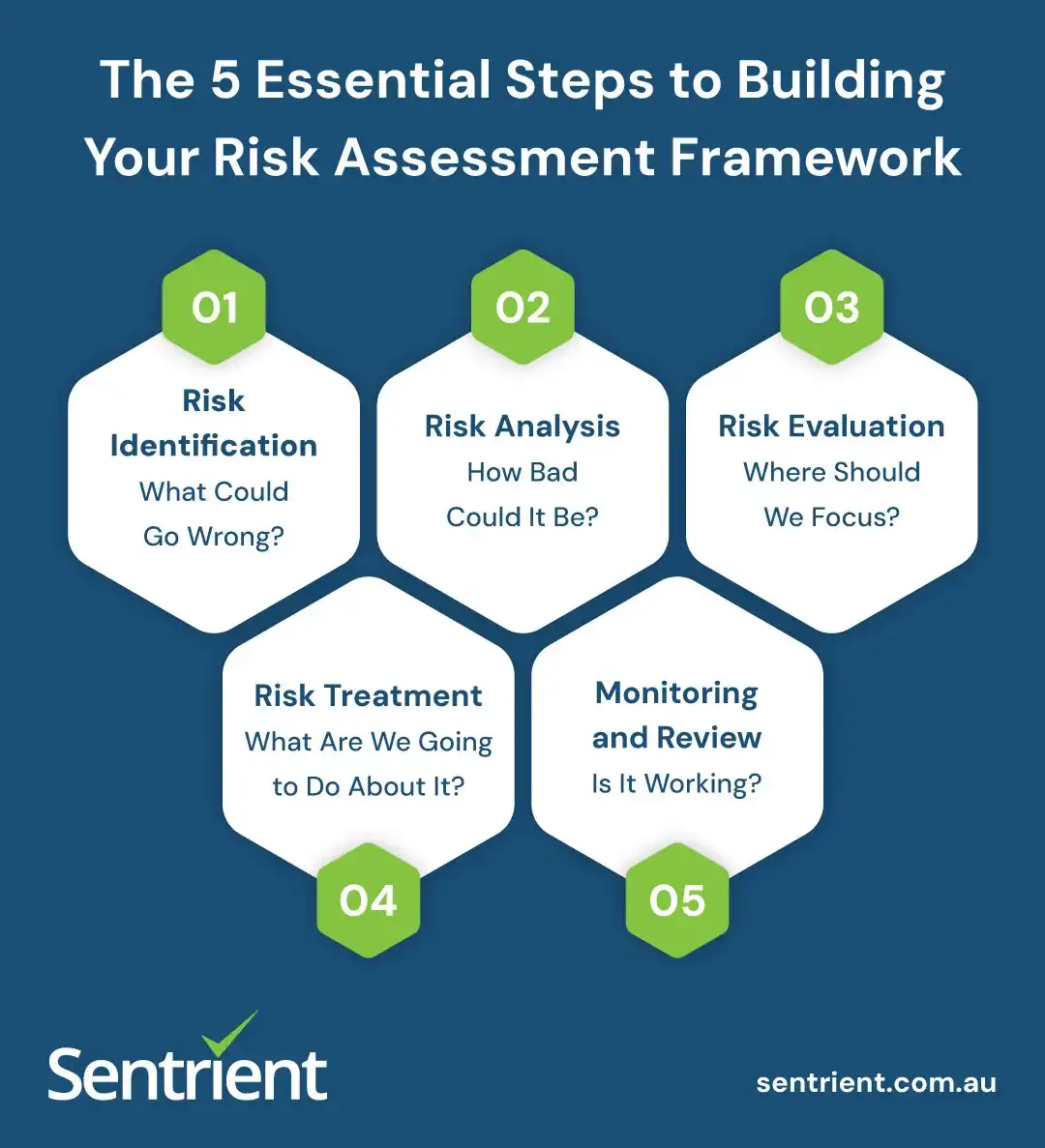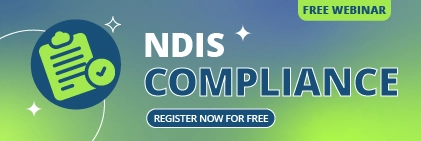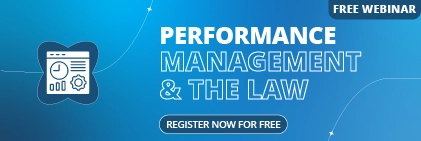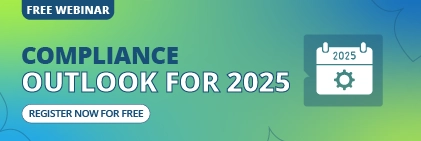How do I build an effective risk assessment framework for my organisation?
This question consistently appears in searches by Australian business professionals seeking practical guidance. Risk management isn’t just a compliance checkbox, it’s an essential business practice that protects your organisation, employees, and reputation.
In today’s rapidly changing business landscape, Australian organisations face an increasingly complex array of risks. From cybersecurity threats to workplace safety concerns, the potential impacts can be devastating without proper management.
This guide breaks down the risk assessment process into five actionable steps, providing you with the knowledge to implement a robust risk assessment framework.
What Is a Risk Assessment Framework?
A risk assessment framework helps organisations make informed decisions, stay compliant, protect assets (including people), and maintain operational stability.
Think of it as your organisation’s early warning system – a proactive approach that helps you spot trouble before it happens and prepare accordingly.
The Australian/New Zealand Standard for Risk Management defines risk as “the effect of uncertainty on objectives.” In practical terms, this means anything that might prevent your organisation from achieving its goals.
Why Do Australian Businesses Need a Risk Assessment Framework?
Australian businesses operate in a unique regulatory environment with specific compliance requirements. Without a structured approach to risk, organisations face:
- Potential legal penalties and regulatory non-compliance
- Financial losses from unmitigated risks
- Damage to reputation and customer trust
- Operational disruptions and inefficiencies
- Workplace safety incidents and employee harm
A robust framework doesn’t just protect, it provides competitive advantage by enabling more confident decision-making and resource allocation.
Beyond compliance, an effective risk framework offers tangible benefits including resource optimisation, better strategic planning, and enhanced organisational resilience. These are all critical advantages in today’s business environment.
The 5 Essential Steps to Building Your Risk Assessment Framework

Step 1: Risk Identification – What Could Go Wrong?
The foundation of effective risk assessment begins with comprehensive identification of potential threats. This critical first step requires input from all areas across your organisation.
Key activities include:
- Conducting stakeholder workshops and interviews
- Reviewing historical incidents and near-misses
- Examining industry data and regulatory requirements
- Performing SWOT analysis
- Evaluating external factors (market conditions, technological changes)
Documentation is crucial – create a risk register that captures each identified risk with a clear description and potential source.
Step 2: Risk Analysis – How Bad Could It Be?
Once you’ve identified potential risks, the next step is understanding their nature and potential impact on your organisation.
For each identified risk, assess:
- Likelihood: How probable is it that this risk will materialise?
- Impact:If it does occur, how severely will it affect your organisation?
This analysis is typically visualised using a risk matrix like the one below:
| Likelihood/Impact | Minor | Moderate | Major | Severe |
|---|---|---|---|---|
| Almost Certain | Medium | High | Extreme | Extreme |
| Likely | Medium | Medium | High | Extreme |
| Possible | Low | Medium | High | High |
| Unlikely | Low | Low | Medium | High |
The resulting risk ratings help prioritise which issues require immediate attention.
Step 3: Risk Evaluation – Where Should We Focus?
Not all risks are created equal. This step involves determining which risks warrant immediate attention based on your organisation’s risk appetite and resources.
Risk evaluation includes:
- Comparing risk levels against established criteria
- Considering business objectives and strategic priorities
- Evaluating existing controls and their effectiveness
- Determining which risks exceed acceptable thresholds
Consider both the risk rating and your organisation’s context – a moderate financial risk might be tolerable, while a low-rated compliance risk could require immediate action due to regulatory requirements.
Step 4: Risk Treatment – What Are We Going to Do About It?
This action oriented step involves developing strategies to address your prioritised risks. For each significant risk, you have four main options:
- Avoid: Eliminate the risk by discontinuing the activity
- Reduce: Implement controls to minimise likelihood or impact
- Transfer: Share the risk through insurance or outsourcing
- Accept: Acknowledge the risk and choose to take no action (for low-level risks)
Document your treatment plans with clear responsibilities, timelines, and required resources. This creates accountability and ensures implementation.
Step 5: Monitoring and Review – Is It Working?
A risk assessment framework isn’t a “set and forget” tool, it requires ongoing attention to remain effective in a changing environment.
Establish a regular review cycle that includes:
- Tracking the implementation of treatment plans
- Evaluating the effectiveness of controls
- Identifying emerging risks
- Updating the risk register accordingly
- Reporting to management and stakeholders
Successful organisations typically review their framework quarterly, with a comprehensive reassessment annually.
Common Challenges and How to Overcome Them
When implementing your risk assessment framework, be prepared for these typical roadblocks:
- Limited Resources: Start small with critical risks and expand gradually.
- Inconsistent Application: Develop standardised tools and templates for consistency.
- Cultural Resistance: Build awareness through training and communication.
- Data Quality Issues: Establish clear definitions and metrics for risk evaluation.
Key Components Every Risk Framework Should Include
For a comprehensive approach aligned with Australian standards, ensure your framework incorporates:
- Governance Structure: Clearly defined roles and responsibilities
- Risk Criteria: Tailored to your organisation’s context and risk appetite
- Documentation System: For capturing and tracking risks and controls
- Communication Plan: For sharing risk information with stakeholders
- Compliance Elements: Addressing Australian regulatory requirements
At a minimum, include a risk management policy, risk register, assessment tools, treatment plans, and regular reporting templates.
How Sentrient’s GRC System Supports Your Risk Assessment Framework
Implementing a risk assessment framework can be challenging without the right tools. Sentrient’s Governance, Risk, and Compliance (GRC) system provides Australian organisations with:
- Intuitive risk assessment tools tailored to Australian regulatory requirements
- Customisable risk matrices and evaluation criteria
- Automated workflows for risk treatment and review cycles
- Comprehensive reporting capabilities for management
- Integration with other compliance and HR functions
Our platform simplifies the process while ensuring nothing falls through the cracks, helping you build a resilient organisation.
Conclusion
A well designed risk assessment framework isn’t just about avoiding problems – it’s about creating organisational resilience and competitive advantage.
By following these five steps and adapting them to your unique context, your Australian business can transform risk management from a compliance exercise into a strategic capability.
Building a risk assessment framework may seem daunting, but the benefits far outweigh the investment. With the right approach and tools like Sentrient’s GRC system, Australian organisations can navigate risks with confidence.
Ready to strengthen your organisation’s risk management capabilities? Learn how Sentrient’s GRC system can help you implement a robust risk assessment framework customised to Australian business requirements.
Request a Demo to learn about our risk management tool today.
FAQs
1. How often should we review our risk assessment framework?
While major reviews should occur annually, quarterly check-ins help ensure your framework remains relevant. Significant organisational changes should trigger additional reviews.
2. What’s the difference between risk assessment and risk management?
Risk assessment is the process of identifying and evaluating potential threats, while risk management encompasses the broader activities of developing strategies and implementing controls.
3. Do small Australian businesses need a formal risk assessment framework?
Yes, though the scale may differ. Even small organisations benefit from structured risk assessment, particularly for compliance with Australian workplace health and safety requirements.
4. How do we determine our organisation’s risk appetite?
Risk appetite should be defined by senior leadership based on strategic objectives, industry standards, and regulatory requirements. This typically involves workshop discussions and board approval.
Read More About Governance, Risk Management, and Compliance:
- The Future of AI in Governance, Risk and Compliance (GRC): A Detailed Guide
- How to Implement a GRC System in Your Business: A Step-by-Step Guide
- Understanding 5×5 Risk Assessment Matrix: A Complete Guide
- 6 Key Benefits Of Implementing GRC Management Software
- 5 Ways To Motivate Learner Engagement In Online GRC Training





